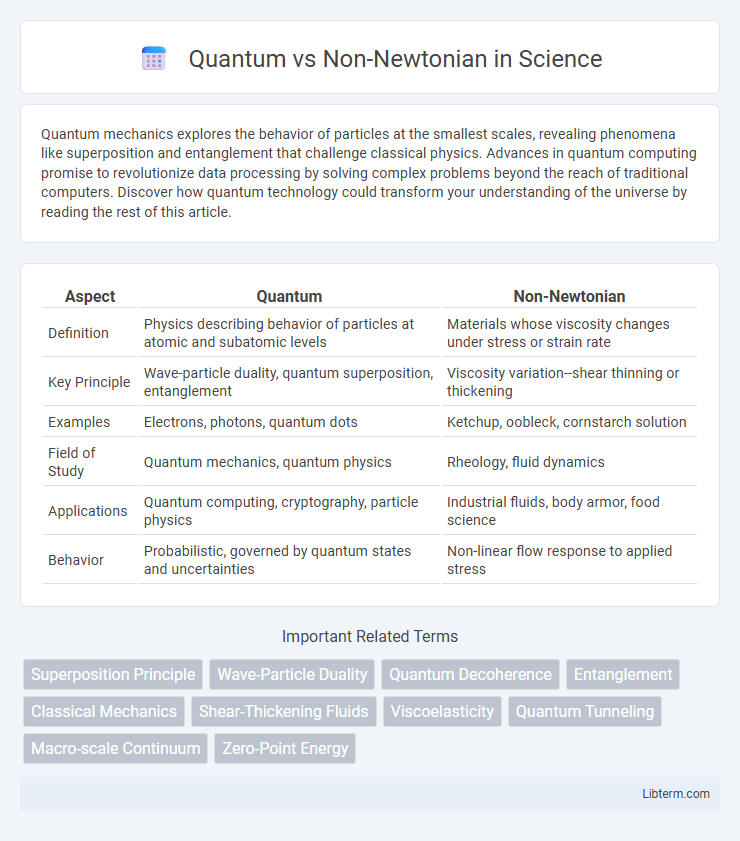Quantum mechanics explores the behavior of particles at the smallest scales, revealing phenomena like superposition and entanglement that challenge classical physics. Advances in quantum computing promise to revolutionize data processing by solving complex problems beyond the reach of traditional computers. Discover how quantum technology could transform your understanding of the universe by reading the rest of this article.
Table of Comparison
| Aspect | Quantum | Non-Newtonian |
|---|---|---|
| Definition | Physics describing behavior of particles at atomic and subatomic levels | Materials whose viscosity changes under stress or strain rate |
| Key Principle | Wave-particle duality, quantum superposition, entanglement | Viscosity variation--shear thinning or thickening |
| Examples | Electrons, photons, quantum dots | Ketchup, oobleck, cornstarch solution |
| Field of Study | Quantum mechanics, quantum physics | Rheology, fluid dynamics |
| Applications | Quantum computing, cryptography, particle physics | Industrial fluids, body armor, food science |
| Behavior | Probabilistic, governed by quantum states and uncertainties | Non-linear flow response to applied stress |
Introduction to Quantum and Non-Newtonian Concepts
Quantum mechanics explores the behavior of particles at atomic and subatomic levels, where wave-particle duality and quantum entanglement define physical phenomena, contrasting classical Newtonian physics that governs macroscopic motion. Non-Newtonian fluids, unlike Newtonian liquids with constant viscosity, exhibit variable viscosity dependent on applied stress or shear rate, revealing unique properties such as shear thinning or thickening. Understanding quantum principles highlights probabilistic outcomes and discrete energy states, while non-Newtonian concepts emphasize complex fluid dynamics beyond traditional linear viscosity models.
Defining Quantum Physics: Key Principles
Quantum physics explores the behavior of matter and energy at atomic and subatomic scales, governed by principles such as wave-particle duality, quantization of energy, and uncertainty. Unlike classical Newtonian physics, quantum mechanics introduces probabilistic outcomes and entanglement, challenging deterministic assumptions. Key concepts include superposition, quantum tunneling, and the Schrodinger equation, which mathematically describe particle behavior beyond classical mechanics.
Understanding Non-Newtonian Mechanics
Non-Newtonian mechanics describe materials whose viscosity changes under stress, differing fundamentally from classical Newtonian fluids with constant viscosity. These substances, like oobleck or cornstarch mixtures, exhibit shear-thickening or shear-thinning behaviors, meaning their resistance to flow varies with applied force. Understanding non-Newtonian mechanics involves analyzing complex flow patterns and stress-strain relationships, essential for applications in material science and engineering.
Historical Development: Quantum vs Non-Newtonian Theories
Quantum theory emerged in the early 20th century with Max Planck's solution to blackbody radiation and Albert Einstein's explanation of the photoelectric effect, fundamentally shifting classical physics by introducing quantized energy levels. Non-Newtonian fluid theory developed in the late 19th and early 20th centuries, with discoveries such as Albert Einstein's work on the viscosity of suspensions, challenging Newton's laws by describing fluids whose flow properties change under stress. Both theories revolutionized their respective fields by expanding understanding beyond classical mechanics, with quantum mechanics addressing atomic and subatomic phenomena and non-Newtonian fluid dynamics explaining complex material behaviors.
Core Differences: Quantum vs Non-Newtonian Dynamics
Quantum dynamics governs the behavior of particles at atomic and subatomic scales through principles like superposition and wave-particle duality, characterized by probabilistic outcomes and wavefunction evolution. Non-Newtonian dynamics, often associated with fluids, describe materials whose viscosity changes under stress, deviating from classical Newtonian fluid behavior, relying on macroscopic physical responses rather than quantum states. The core difference lies in quantum dynamics exploring fundamental particles and forces with intrinsic uncertainty, while non-Newtonian dynamics address complex, stress-dependent material properties in continuum mechanics.
Real-world Applications: Quantum Technologies
Quantum technologies enable breakthroughs in cryptography, enabling unhackable communication through quantum key distribution, while advancing precision in sensors and imaging systems used in medical diagnostics and navigation. Non-Newtonian fluids find practical applications in impact-resistant materials and adaptive dampers but lack the transformative computational and communication capabilities of quantum systems. The exploitation of quantum entanglement and superposition powers innovation in real-world applications like quantum computing, enhancing drug discovery, optimization problems, and secure information processing.
Everyday Examples: Non-Newtonian Materials and Phenomena
Non-Newtonian materials like oobleck, a cornstarch and water mixture, exhibit viscosity changes under stress, making them thicken when stirred or impacted, unlike classical Newtonian fluids whose viscosity remains constant. Everyday phenomena such as quicksand and ketchup illustrate non-Newtonian behavior, with their flow properties shifting based on applied force or shear rate. These materials are distinct from quantum systems, which operate at atomic scales and involve phenomena like superposition and entanglement, not observable in daily macroscopic fluid behaviors.
Challenges in Unifying Quantum and Non-Newtonian Models
Unifying quantum mechanics with non-Newtonian fluid dynamics presents significant challenges due to their fundamentally different mathematical frameworks and scales of application. Quantum systems operate on probabilistic wavefunctions within a Hilbert space, whereas non-Newtonian fluids exhibit complex, often nonlinear rheological behavior governed by continuum mechanics. Bridging these models requires novel approaches to reconcile discrete quantum effects with continuum-based, time-dependent stress-strain relationships inherent in non-Newtonian fluids.
Future Perspectives: Advancements and Innovations
Quantum computing promises to revolutionize data processing with unprecedented speed and problem-solving capabilities, while non-Newtonian fluid research drives innovations in adaptive materials and smart systems. Future advancements in quantum algorithms will enable breakthroughs in cryptography, drug discovery, and complex simulations, whereas non-Newtonian technologies will enhance impact-resistant gear, flexible robotics, and responsive architectural designs. Integrating these fields could lead to hybrid applications that leverage quantum mechanics for controlling non-Newtonian material behaviors at the nanoscale, opening avenues for next-generation smart materials and quantum-enhanced fluid systems.
Conclusion: Impact on Science and Technology
Quantum mechanics revolutionizes science by explaining phenomena at atomic and subatomic scales, enabling advancements in quantum computing, cryptography, and materials science. Non-Newtonian fluid dynamics contribute to engineering and biotechnology by improving the design of prosthetics, soft robotics, and industrial processes involving complex fluids. Together, they drive innovation across disciplines by expanding our understanding of fundamental physics and enhancing practical applications.
Quantum Infographic

 libterm.com
libterm.com